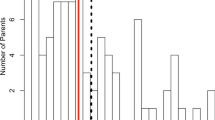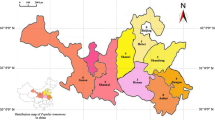Abstract
Polymix breeding with paternity analysis (PMX/WPA) has been proposed as an alternative to traditional full-sib breeding and testing schemes. To fully capture the benefits of PMX/WPA, differential reproductive success (DRS) of pollen parents used in the polymix must be modest. DRS was evaluated in an operational test of PMX/WPA for a hybrid poplar breeding program. A 16-parent pollen polymix (Populus nigra L.) was used to pollinate seven clones of Populus deltoides (Bartr. ex. Marshall) under greenhouse breeding conditions. Progeny were grown out briefly and randomly sampled (357) prior to out-planting in field trials. Twenty-eight simple sequence repeat (SSR) loci were evaluated and 15 were selected for genetic characterization in small populations of three Populus spp (P. nigra, P. deltoides, and P. balsamifera spp trichocarpa Torr. & Gray). Seven loci were ultimately selected for paternity analysis of progeny. The average exclusion probability of the seven loci in P. nigra was 0.604; combined, the theoretical exclusion probability was 0.9999. However, only 95% of sampled progeny were unambiguously assigned a single paternal parent. Missing data likely accounted for most of the ambiguity. DRS was statistically significant though not prohibitive for practical utility of PMX/WPA as a breeding system. Of the 112 potential crosses in this study, 92 were represented. Eight of the 16 pollen parents contributed 83% of the progeny. Good pollen vigor, as measured by germination percent, did not ensure paternal success, but poor vigor was associated with lack of paternal success. PMX/WPA appears to be logistically and economically attractive for hybrid poplar breeding and testing.
Similar content being viewed by others
References
Brewbaker JL, Kwack BH (1963) The essential role of calcium ion in pollen germination and pollen tube growth. Am J Bot 50:859–865
Brunner AM, Rottmann WH, Sheppard LA, Krutovskii K, DiFazio SP, Leonardi S, Strauss SH (2000) Structure and expression of duplicate AGAMOUS orthologues in poplar. Plant Mol Biol 44:619–634
Dickmann DI, Stuart KW (1983) The culture of poplars in Eastern North America. Michigan State University, East Lansing, MI
Lambeth C, Lee B-C, O’Malley D, Wheeler NC (2001) Polymix breeding with parental analysis of progeny: an alternative to full-sib breeding and testing. Theor Appl Genet 103:930–943
Marshall TC, Slate J, Kruuk L, Pemberton JM (1998) Statistical confidence for likelihood-based paternity inference in natural populations. Mol Ecol 7(5):639–655
Melchior GH, Seitz FW (1968) Interspezifische kreuzungssterilitat innerhalb der pappelsektion Aigeriros. [Interspecific cross sterility within the poplar section Aigerios], translated from German. Silvae Genet 17:88–93
Mulcahy D (1983) Models of pollen-tube competition in Geranium maculatum. In: Real L (ed) Pollination Biology, Academic, New York, pp 151–161
Nakamura RR, Wheeler NC (1992) Pollen competition and paternal success in Douglas-fir. Evolution 46:846–851
Nikkanen T, Aronen T, Haggman H, Venäläinen M (2000) Variation in pollen viability among Picea abies genotypes—potential for unequal paternal success. Theor Appl Genet 101:511–518
Quesada M, Winsor JA, Sephenson AG (1993) Effects of pollen competition on progeny performance in a heterozygous cucurbit. Am Nat 142:694–706
Smouse PE, Meagher TR (1994) Genetic analysis of male reproductive contributions in Chamaelirium luteum (L) Gray (Liliacease). Genetics 136:313–332
Smulders MJM, Van Der Schoot J, Arens P, Vosman B (2001) Trinucleotide repeat microsatellite markers for black poplar (Populus nigra L.). Molec Ecol Notes 1(3):188–190
Stanton BJ, Villar M (1996) Controlled reproduction of Populus. In: Stettler RF, Bradshaw HD Jr, Heilman PE, Hinckley TM (eds) Biology of Populus and its implication for management and conservation. Ch 5. NRC Research, Ottawa, Ontario, Canada, pp 113–138
Stettler RF (1968) Irradiated mentor pollen: its use in remote hybridization of black cottonwood. Nature 219:746–747
Tuskan GA, Gunter LE, Yang ZK, Yin TM, Sewell MM, DiFazio SP (2004) Characterization of microsatellites revealed by genomic sequencing of Populus trichocarpa. Can J For Res 34(1):85–93
van der Schoot J, Pospiskova M, Vosman B, Smulders MJM (2000) Development and characterization of microsatellite markers in black poplar (Populus nigra L.). Theor Appl Genet 101(1–2):317–322
Yin TM, DiFazio SP, Gunter LE, Riemenschneider D, Tuskan GA (2004) Large-scale heterospecific segregation distortion in Populus revealed by a dense genetic map. Theor Appl Genet 109:451–463
Acknowledgements
We wish to thank Dr. Steve DiFazio from the Environmental Sciences Division, Oak Ridge National Laboratory, and Dr. Steven Strauss, Department of Forest Science, Oregon State University for providing aliquots of primers needed to amplify 28 SSR loci evaluated in this study. We are grateful to Chuck Wierman, Brian Stanton and Clem Lambeth for reviewing earlier versions of this manuscript, and to anonymous reviewers at the journal.
Author information
Authors and Affiliations
Corresponding author
Rights and permissions
About this article
Cite this article
Wheeler, N., Payne, P., Hipkins, V. et al. Polymix breeding with paternity analysis in Populus: a test for differential reproductive success (DRS) among pollen donors. Tree Genetics & Genomes 2, 53–60 (2006). https://doi.org/10.1007/s11295-005-0033-x
Received:
Accepted:
Published:
Issue Date:
DOI: https://doi.org/10.1007/s11295-005-0033-x




